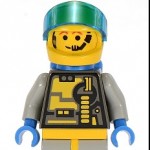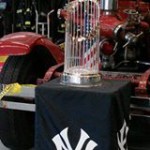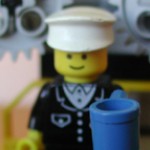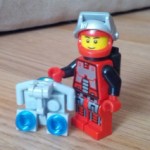Home › Forums › All Things LEGO! › The Ultimate LEGO Element
- This topic has 10 replies, 6 voices, and was last updated 8 years, 2 months ago by
 Dan Efran.
Dan Efran.
-
AuthorPosts
-
January 6, 2017 at 10:32 am #19477
 Rich MillichParticipant
Rich MillichParticipantHere, professional modeler Ken McConnell reveals the Industrial Light and Magic “Universal Greebile” that they felt could be used anywhere for detail.
I ask this then: for your style of building, what has become your Universal Element that you wind up using over and over and over for various things?
January 6, 2017 at 12:57 pm #19481 Matt RedfieldKeymaster
Matt RedfieldKeymasterCheese. Definitely cheese.
But only because huskies aren’t available in LUGBulk.
January 6, 2017 at 4:15 pm #19484 Rich MillichParticipant
Rich MillichParticipantFor me, it’s the good old 1×1 round plate. The lip on it is a rib when they’re stacked. It forms a cap on any stud. The antistud serves as a thruster port or a HUD in a pinch. They form buffer transitions in color blocking between larger parts. In transparent colors, they add clutch while being easier to remove. It fits into places where a 1×1 plate won’t. It can even serve as a rotational hinge point when sandwiched. 1×1 round plate is my Universal Element.
-
This reply was modified 8 years, 3 months ago by
 Rich Millich.
Rich Millich.
January 6, 2017 at 5:55 pm #19491 PeteParticipant
PeteParticipantThe Ghettoblaster that is available in LUGbulk
January 7, 2017 at 12:32 am #19502 Benjamin C GoodParticipant
Benjamin C GoodParticipantI’ve seen interviews with noted builders where they ask them what are their three favorite pieces, and not surprisingly I remember cheese being a common answer. Also popular are the 1×1 SNOT and headlight bricks. The ghettoblaster is one of the most useful parts of all time, no one said ever. Plus, I’m pretty sure Pete meant to say Port-o-Potty stickers.
January 8, 2017 at 9:56 am #19531 DanParticipant
DanParticipantI’d agree with the 1×1 round plated, but it depends on the build. Sometimes 1×1 round tiles are great too!
January 20, 2017 at 2:43 pm #19877 Dan EfranParticipant
Dan EfranParticipantDepends exactly what you’re asking about. Greebles specifically? Or just parts as parts….
For an all-around universal part, I find the 1×1 brick with studs on all sides to be essential. I use at least one in nearly every MOC. I can’t really imagine building without it.
For surface details, I don’t have a single Universal Greeble, but I do have a small suite of Go-To Greebles. I find that if I start with 1×1 round plates, 1×1 round tiles, bars 4L (lightsaber blades), lightsaber handles, 1×2 grille tiles, and 1×1 clip top tiles, I can greeble effectively for quite a while before I need to mix in other parts. Second tier favorites include ribbed hoses, taps, pneumatic tees, 1×1 plates, 1×2 jumper plates, headlight bricks, and grated cheese. After that maybe it’s time for some 2×2 round tiles, 2×2 tiles, 2×2 jumper plates, and 2×2 radar dishes. That’s usually enough parts variety for solid generic greebling…though it’s generally better to half-design half-functional-looking pseudo-subsystems than to just spray dots and lines everywhere.
If I had to pick just one greeble part, I think I’d agree with the 1×1 round tile as both essential and versatile.
As for the “ILM Universal Greeblie” in the link…it doesn’t seem all that universal to me…I think the closest LEGO equivalent is the 33291 Plate, Round 1 x 1 with Flower Edge (4 Knobs). OK, I guess if that came in gray I’d use it pretty often.
January 20, 2017 at 10:05 pm #19889 Benjamin C GoodParticipant
Benjamin C GoodParticipant>> For surface details, I don’t have a single Universal Greeble, but I do have a small suite of Go-To Greebles. I find that if I start with 1×1 round plates, 1×1 round tiles, bars 4L (lightsaber blades), lightsaber handles, 1×2 grille tiles, and 1×1 clip top tiles, I can greeble effectively for quite a while before I need to mix in other parts. Second tier favorites include ribbed hoses, taps, pneumatic tees, 1×1 plates, 1×2 jumper plates, headlight bricks, and grated cheese. After that maybe it’s time for some 2×2 round tiles, 2×2 tiles, 2×2 jumper plates, and 2×2 radar dishes.
This is interesting to me though cause of something it made me think of… at BrickFair years ago, I listened to Arthur Gugick do his talk, he’s best known for building microscale models of famous architectural landmarks. Towards that end, he was discussing how just about any part is useful as long as you have a lot of them, and he said to help himself, he took a 16×16 plate and he affixed all the most common parts to it for reference while he was planning and building. And he also told us that he was then pleasantly surprised when he subsequently learned that a lot of the Lego set designers do the same thing when they’re working.
So reading Dan’s list, I’m picturing him doing the something similar with all his space parts, although I don’t know that he actually does it. I haven’t actually tried it, although admittedly my most common method is to simply get out all the bags of parts, which creates a big mess and generates a lot of cleanup time.
January 21, 2017 at 11:00 am #19902 Dan EfranParticipant
Dan EfranParticipantInteresting.
I definitely don’t ever make a reference catalog plate like that. I know what most parts look like already, so I don’t see much reason to do that.
Usually I just pull the half-dozen most relevant bins off the shelf, stack them around me, and grab parts from their bags as needed. (My storage system is plastic shoeboxes and ziploc bags, similar to the LUG supply.) Sometimes, though, I’ll fill a tray (e.g. a box lid) with the kind of parts I expect to use, making an unsorted mini-collection from which to build. That works pretty well for things like greebling where I expect to use a limited palette of parts. It can be faster to build from a jumble of parts than from bags, if the jumble is very relevant. It does lead to a lot of cleanup time, though, so I prefer to work directly from sorted when I can.
I once read about a microscale architecture builder – I don’t remember if it’s the same one you mention – who made up a little kit of architecture-specific universal parts to travel with. I believe it was in one of those toolbox compartment box thingies, was mostly one or two colors, and really focused on microscale-archtecture essential parts. I thought that was very clever. I’ve often been tempted to make up a “greeble kit” similarly, with an extra supply of the parts I mentioned in this thread, separate from my main sorted supply. Then I could just grab that kit at greebling time, instead of hunting down the relevant bags over and over.
On the other hand, I try not to get complacent and greeble everything the same way. I prefer to experiment with new combinations whenever possible, and having to dig out a new kit of parts from sorted each time helps keep things fresh, maybe.
January 28, 2017 at 9:03 pm #20121 Benjamin C GoodParticipant
Benjamin C GoodParticipant>> I once read about a microscale architecture builder – I don’t remember if it’s the same one you mention – who made up a little kit of architecture-specific universal parts to travel with. I believe it was in one of those toolbox compartment box thingies, was mostly one or two colors, and really focused on microscale-archtecture essential parts. I thought that was very clever.
I’m not sure if that’s the same guy or not. I’ve never seen anybody else do that. Generally, I’ve found it unnecessary; when you put something on display, you’re already done building it, so there’s nothing else you would need more parts for. The one exception is GBC. The GBC guys carry around big tool boxes of axles, gears, bushings, beams, bricks, connectors, etc, because unlike most Lego builds, GBC modules can fail or break while on display in unanticipated ways and require rebuilds on the fly. I have a whole bag of twisted axles, stripped gears, and split connectors that were destroyed during public hours and had to be replaced on the spot (I call it my Bag of Shame).
January 29, 2017 at 4:44 pm #20132 Dan EfranParticipant
Dan EfranParticipantGenerally, I’ve found it unnecessary; when you put something on display, you’re already done building it, so there’s nothing else you would need more parts for.
No, I mean he carried an “essential” palette of parts when traveling, for doing plein air sketches of architecture he was visiting.
-
This reply was modified 8 years, 3 months ago by
-
AuthorPosts
- You must be logged in to reply to this topic.
